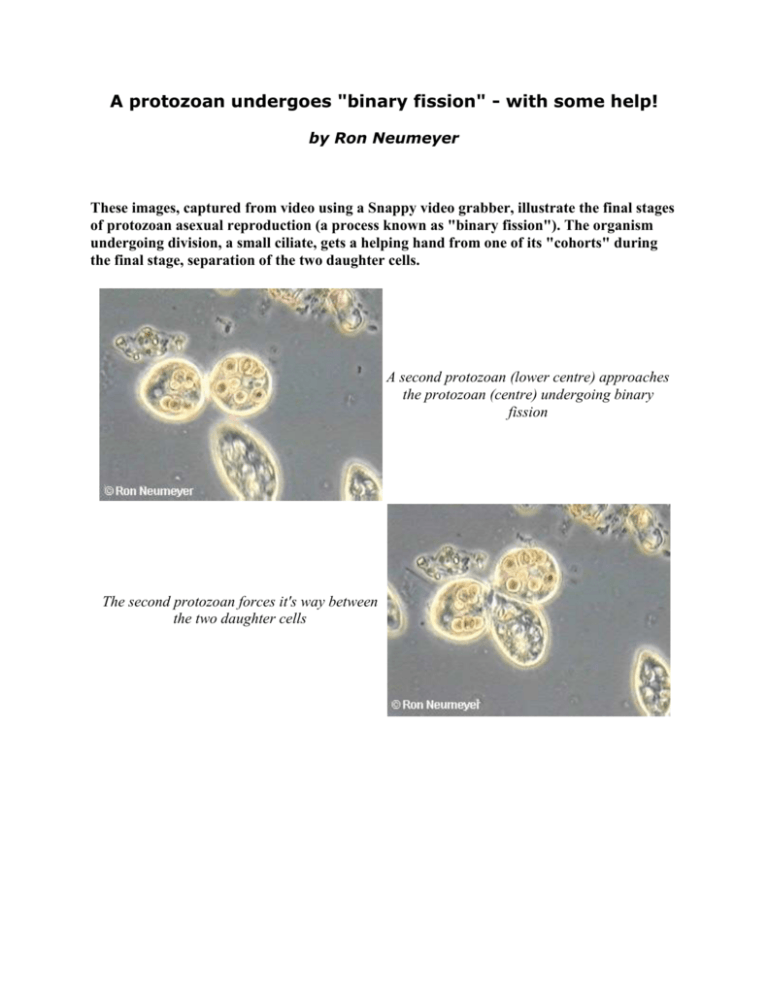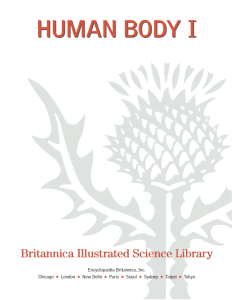
A protozoan undergoes "binary fission" - with some help!
by Ron Neumeyer
These images, captured from video using a Snappy video grabber, illustrate the final stages
of protozoan asexual reproduction (a process known as "binary fission"). The organism
undergoing division, a small ciliate, gets a helping hand from one of its "cohorts" during
the final stage, separation of the two daughter cells.
A second protozoan (lower centre) approaches
the protozoan (centre) undergoing binary
fission
The second protozoan forces it's way between
the two daughter cells
Aiding the binary fission process in a rather
unorthodox way!
Binary fission generally produces daughter cells with genetic material (DNA) identical to
that of the parent. It is an efficient way for protozoa to increase in number during periods
when environmental conditions are relatively stable. However, when environmental
conditions begin to change, sexual reproduction generally becomes more prevalent. Sexual
reproduction allows for the mixing of DNA among the various strains (asexual daughters)
of a local protozoan population. Shuffling the deck in this manner produces cells which are
genetically different from each other, an important characteristic as genetic make-up
determines how cells respond to their environment. A genetically diverse population has
more "options" in the face of changing conditions. In the biological world survival of the
species is the ultimate objective. The more diverse a species gene pool, the greater the
likelihood that it will persist.
Comments to the author Ron Neumeyer welcomed.
Microscopy UK Front Page
Micscape Magazine
Article Library
© Microscopy UK or their contributors.
Please report any Web problems or offer general comments to the Micscape Editor,
via the contact on current Micscape Index.
Micscape is the on-line monthly magazine of the Microscopy UK web
site at Microscopy-UK
© Onview.net Ltd, Microscopy-UK, and all contributors 1995 onwards. All rights reserved. Main site is at www.microscopyuk.org.uk with full mirror at www.microscopy-uk.net.
Original Text:
Show alternative translations
http://www.microscopy-uk.org.uk/mag/indexmag.html?http://www.microscopyuk.org.uk/mag/art98/celldiv.html
Fission (biology)
From Wikipedia, the free encyclopedia
(Redirected from Binary fission)
Jump to: navigation, search
Binary fission
In biology, fission is the carp of a body, population, or species into parts and the regeneration of
those parts into separate individuals.[1][2][3] Binary fission, or prokaryotic fission, is a form of
asexual reproduction and cell division used by all prokaryotes, some protozoa, and some
organelles within eukaryotic organisms. This process results in the reproduction of a living
prokaryotic cell by division into two parts that each have the potential to grow to the size of the
original cell.
Mitosis and cytokinesis are not the same as binary fission. To be specific, binary fission cannot
be divided into prophase, metaphase, anaphase, and telophase because prokaryotes have no
nucleus and no centromeres. The ability of some multicellular animals, such as echinoderms and
flatworms, to regenerate two whole organisms after having been cut in half, is also not the same
as binary fission. Neither is vegetative reproduction of plants.
[edit] References
1. ^ Carlson, B. M. (2007). Principals of regenerative biology.. Elsevier Academic Press. pp. 379.
ISBN 0123694396.
2. ^ Boulay, R. L.; Galarza, J. A.; Che, B.; Hefetz, A.; Lenoir, A.; van Oudenhove, L.; Cerda, X. (2010).
"Intraspecific competition affects population size and resource allocation in an ant dispersing by
colony fission.". Ecology 91 (11): 3312–3321. doi:10.1890/09-1520.1.
http://www.esajournals.org/doi/full/10.1890/09-1520.1.
3. ^ Hubbell, S. (2003). "Modes of speciation and the lifespans of species under neutrality: a
response to the comment of Robert E. Ricklefs.". Oikos 100 (1): 193–199. doi:10.1034/j.16000706.2003.12450.x. http://onlinelibrary.wiley.com/doi/10.1034/j.16000706.2003.12450.x/abstract.
Retrieved from "http://en.wikipedia.org/wiki/Fission_(biology)"
View page ratings
Rate this page
What's this?
Trustworthy
Objective
Complete
Well-written
I am highly knowledgeable about this topic (optional)
I have a relevant college/university degree
It is part of my profession
It is a deep personal passion
The source of my knowledge is not listed here
I would like to help improve Wikipedia, send me an e-mail (optional)
We will send you a confirmation e-mail. We will not share your address with anyone. (Privacy policy)
Submit ratings
Saved successfully
Your ratings have not been submitted yet
Your ratings have expired
Please reevaluate this page and submit new ratings.
An error has occured. Please try again later.
Thanks! Your ratings have been saved.
Please take a moment to complete a short survey.
Start survey Maybe later
Thanks! Your ratings have been saved.
Do you want to create an account?
An account will help you track your edits, get involved in discussions, and be a part of the community.
Create an accountorLog in Maybe later
Thanks! Your ratings have been saved.
Did you know that you can edit this page?
Edit this page Maybe later
Categories: Bacteria | Cell cycle | Reproduction | Microbiology
Personal tools
Log in / create account
Namespaces
Article
Discussion
Variants
Views
Read
Edit
View history
Actions
Search
Special:Search
Navigation
Main page
Contents
Featured content
Current events
Random article
Donate to Wikipedia
Interaction
Help
About Wikipedia
Community portal
Recent changes
Contact Wikipedia
Toolbox
What links here
Related changes
Upload file
Special pages
Permanent link
Cite this page
Rate this page
Print/export
Create a book
Download as PDF
Printable version
Languages
ال عرب ية
Català
Česky
Deutsch
Ελληνικά
Español
Français
Hrvatski
עברית
Kreyòl ayisyen
Italiano
Nederlands
日本語
Português
Simple English
This page was last modified on 2 August 2011 at 00:57.
Text is available under the Creative Commons Attribution-ShareAlike License; additional terms
may apply. See Terms of use for details.
Wikipedia® is a registered trademark of the Wikimedia Foundation, Inc., a non-profit
organization.
Contact us
Privacy policy
About Wikipedia
Disclaimers
Mobile view
http://en.wikipedia.org/wiki/Binary_fission
Fission (biology)
From Wikipedia, the free encyclopedia
Jump to: navigation, search
Binary fission
In biology, fission is the carp of a body, population, or species into parts and the regeneration of
those parts into separate individuals.[1][2][3] Binary fission, or prokaryotic fission, is a form of
asexual reproduction and cell division used by all prokaryotes, some protozoa, and some
organelles within eukaryotic organisms. This process results in the reproduction of a living
prokaryotic cell by division into two parts that each have the potential to grow to the size of the
original cell.
Mitosis and cytokinesis are not the same as binary fission. To be specific, binary fission cannot
be divided into prophase, metaphase, anaphase, and telophase because prokaryotes have no
nucleus and no centromeres. The ability of some multicellular animals, such as echinoderms and
flatworms, to regenerate two whole organisms after having been cut in half, is also not the same
as binary fission. Neither is vegetative reproduction of plants.
[edit] References
1. ^ Carlson, B. M. (2007). Principals of regenerative biology.. Elsevier Academic Press. pp. 379.
ISBN 0123694396.
2. ^ Boulay, R. L.; Galarza, J. A.; Che, B.; Hefetz, A.; Lenoir, A.; van Oudenhove, L.; Cerda, X. (2010).
"Intraspecific competition affects population size and resource allocation in an ant dispersing by
colony fission.". Ecology 91 (11): 3312–3321. doi:10.1890/09-1520.1.
http://www.esajournals.org/doi/full/10.1890/09-1520.1.
3. ^ Hubbell, S. (2003). "Modes of speciation and the lifespans of species under neutrality: a
response to the comment of Robert E. Ricklefs.". Oikos 100 (1): 193–199. doi:10.1034/j.16000706.2003.12450.x. http://onlinelibrary.wiley.com/doi/10.1034/j.16000706.2003.12450.x/abstract.
Retrieved from "http://en.wikipedia.org/wiki/Fission_(biology)"
View page ratings
Rate this page
What's this?
Trustworthy
Objective
Complete
Well-written
I am highly knowledgeable about this topic (optional)
I have a relevant college/university degree
It is part of my profession
It is a deep personal passion
The source of my knowledge is not listed here
I would like to help improve Wikipedia, send me an e-mail (optional)
We will send you a confirmation e-mail. We will not share your address with anyone. (Privacy policy)
Submit ratings
Saved successfully
Your ratings have not been submitted yet
Your ratings have expired
Please reevaluate this page and submit new ratings.
An error has occured. Please try again later.
Thanks! Your ratings have been saved.
Please take a moment to complete a short survey.
Start survey Maybe later
Thanks! Your ratings have been saved.
Do you want to create an account?
An account will help you track your edits, get involved in discussions, and be a part of the community.
Create an accountorLog in Maybe later
Thanks! Your ratings have been saved.
Did you know that you can edit this page?
Edit this page Maybe later
Categories: Bacteria | Cell cycle | Reproduction | Microbiology
Personal tools
Log in / create account
Namespaces
Article
Discussion
Variants
Views
Read
Edit
View history
Actions
Search
Special:Search
Navigation
Main page
Contents
Featured content
Current events
Random article
Donate to Wikipedia
Interaction
Help
About Wikipedia
Community portal
Recent changes
Contact Wikipedia
Toolbox
What links here
Related changes
Upload file
Special pages
Permanent link
Cite this page
Rate this page
Print/export
Create a book
Download as PDF
Printable version
Languages
ال عرب ية
Català
Česky
Deutsch
Ελληνικά
Español
Français
Hrvatski
עברית
Kreyòl ayisyen
Italiano
Nederlands
日本語
Português
Simple English
This page was last modified on 2 August 2011 at 00:57.
Text is available under the Creative Commons Attribution-ShareAlike License; additional terms
may apply. See Terms of use for details.
Wikipedia® is a registered trademark of the Wikimedia Foundation, Inc., a non-profit
organization.
Contact us
Privacy policy
About Wikipedia
Disclaimers
Mobile view
http://en.wikipedia.org/wiki/Fission_%28biology%29
HOME
BROWSE
SHOP
BLOG
ADVOCACY
HELP
LOG IN
With all of these words
With the exact phrase
With any of these words
Without these words
<script
src="http://adserver.adtechus.com/addyn/3.0/5308.1/1371248/0/3603/ADTECH;target=_blank;grp=36
4;key=false;kvqsegs=D;kvchannel=SCIENCE;misc=1249967340916"></script>
Username:
Password:
Log
In
Remember meForgot your password?
Create a new workspace
Help
/EBchecked/topic
"Email" is the e-mail address you used when you registered.
"Password" is case sensitive.
If you need additional assistance, please contact customer support.
Enter the e-mail address you used when enrolling for Britannica Premium Service and we will e-mail
your password to you.
Search Site:
protozoan
Advanced Search
Home
Encyclopædia Britannica (2)
- Reproduction and life cycles
Article
Features of protozoans
Natural history
o Size range and diversity of structure
Flagellated protozoans
Amoebae and pseudopodia
Ciliated protozoans
Parasitic protozoans
o Distribution and abundance
o Ecological and industrial importance of protozoans
o Protozoans and disease
Form and function
o The protozoan cell
o Characteristics of locomotion
Flagellar propulsion
Cilium structure and beat
Amoeboid movement
o Respiration and other energy-generating pathways
Aerobic protozoans
Anaerobic protozoans
Hydrogenosomes
Mitosomes and glycosomes
o Carbon acquisition and nutrition
Mechanisms of food ingestion
Food vacuoles
Food selection
Mixotrophy
Photosynthesis and plastid acquisition
Symbiotic mixotrophy
Mixotrophy in planktonic protozoans
o Reproduction and life cycles
Mechanisms of asexual reproduction
Mechanisms of sexual reproduction
Conjugation in ciliates
Autogamy and modified conjugation
Parasitic protozoan life cycles
o Adaptations
Evolution and paleontology
Classification
o General principles
o Diagnostic features
o Annotated classification
Additional Reading
Related Articles
External Web sites
Citations
EDIT
SAVE
PRINT
E-MAIL
Video, Images & Audio
Related Articles, Ebooks & More
Web Links
Article History
Contributors
Dictionary & Thesaurus
Widgets
<script
src="http://adserver.adtechus.com/addyn/3.0/5308.1/1985268/0/5/ADTECH;target=_blank;grp=364;ke
y=false;kvqsegs=D;misc=1249967340840"></script>
<script
src="http://adserver.adtechus.com/addyn/3.0/5308.1/1371263/0/5/ADTECH;target=_blank;grp=364;ke
y=false;kvqsegs=D;kvchannel=SCIENCE;misc=1249967340842"></script>
<script
src="http://adserver.adtechus.com/addyn/3.0/5308.1/1371243/0/225/ADTECH;target=_blank;grp=364;
key=false;kvqsegs=D;kvtopicid=480488;kvchannel=SCIENCE;misc=1249967340834"></script>
protozoan
Reproduction and life cycles
Asexual reproduction is the most common means of replication by protozoans. The ability to
undergo a sexual phase is confined to the ciliates, the apicomplexans, and restricted taxa among
the flagellated and amoeboid organisms. Moreover, sexual reproduction does not always result in
an immediate increase in cell numbers but may simply be a means of exchanging genetic
material between individuals of the same species (i.e., conjugation). Free-living protozoans
normally resort to sexual reproduction only when environmental conditions become adverse,
because this mode of reproduction enhances genetic variation through mechanisms such as
mutation and chromosomal ... (100 of 13348 words)
LINKS
Other Britannica Sites
Get involved Share
Articles from Britannica encyclopedias for elementary and high school students.
Protozoan - Children's Encyclopedia (Ages 8-11)
Protozoans are simple organisms, or living things. They belong to a group of organisms
called protists, which are neither plants nor animals. Most protozoans are so tiny that they
can be seen only with a microscope. Amoebas and paramecia are types of protozoan.
protozoan - Student Encyclopedia (Ages 11 and up)
Protozoans are typically microscopic, single-celled organisms. Unlike bacteria and
archaea, they are eukaryotic. This means that they have a distinct nucleus. Also, unlike
single-celled algae, protozoans cannot make their own food, so they eat other organisms.
For this reason, protozoans were once considered animals. The term protozoan comes
from the Greek words protos, meaning "first," and zoion, meaning "animal." Protozoans
make up a variety of groups of organisms within the kingdom Protista, though these
groups do not necessarily share a common evolutionary history.
LINKS
External Web Sites
The topic protozoan is discussed at the following external Web sites.
Glass Protozoa
Cornell University - Protozoa and Microsporidia
Onview.net Ltd - Protozoan
Virtual Education - Protozoa
Zipcode Zoo - Protozoa
Aberystwyth University - Protozoa I
Lander University - Protozoa
Royal Society of Chemistry - Protozoan
Midwest Institute for Biological Control - Protozoa
How Stuff Works - Science - Protozoan
Monroe County Women’s Disability Network - Protozoa
History of The Universe - Protozoa
BC Parks - Protozoan
The Physics Hypertextbook - Diameter of a Protozoan
The Pennsylvania State University - Protozoan Diseases
Citations
MLA Style:
"protozoan." Encyclopædia Britannica. Encyclopædia Britannica Online. Encyclopædia
Britannica, 2011. Web. 29 Aug. 2011.
<http://www.britannica.com/EBchecked/topic/480488/protozoan>.
APA Style:
protozoan. (2011). In Encyclopædia Britannica. Retrieved from
http://www.britannica.com/EBchecked/topic/480488/protozoan
About Us
Privacy Policy
Terms of Use
RSS Feeds
E-mail Updates
Contact Us
Advertise with Us
Games
MORE...
VIDEOS
single-celled organism; paramecium [Encyclopædia Britannica, Inc.]
ciliate: locomotion [Encyclopædia Britannica, Inc.]
cilium: structure and movement of cilia and flagella [Encyclopædia Britannica, Inc.]
Paramecium [Encyclopædia Britannica, Inc.]
bacteria: helping animals digest
IMAGES
sea sparkle [Douglas P. Wilson]
amoeba [Russ Kinne/Photo Researchers]
representative protozoans [© Merriam-Webster Inc.]
Volvox: glass model of colony [Courtesy of the American Museum of Natural History, New York
City]
dinoflagellate; Ceratium tripos [Eric V. Grave]
red tide [R.F. Head—The National Audubon Society Collection/Photo Researchers]
radiolarian: glass model [Courtesy of the American Museum of Natural History, New York City]
Euplotes patella [Philip Feinberg, Fellow, New York Microscopical Society.]
oligotrich; Halteria grandinella [J.M. Langham]
trypanosome: trypanosome with human red blood cells [John J. Lee]
Trypanosoma cruzi [Dr. Myron G. Schultz/Centers for Disease Control and Prevention (CDC)
(Image Number: 613)]
blackwater fever [Centers for Disease Control and Prevention (CDC) (Image Numer: 5856)]
Trichomonas vaginalis [A.L. Leu]
amoeba: amoeba engulfing a ciliate [Roman Vishniac]
suctorian; Podophrya fixa [Walter Dawn]
Plasmodium vivax: Plasmodium vivax in red blood cell [A.L. Leu]
conjugation [Damián H. Zanette]
malaria: life cycle of a malaria parasite [Encyclopædia Britannica, Inc.]
Entamoeba coli [A.L. Leu]
plant: approximate numbers of named species [Encyclopædia Britannica, Inc.]
lysosome: intracellular digestion [Encyclopædia Britannica, Inc.]
Assorted References
characteristics (in protist (biology): General features; in protist (biology): Ecology )
classification (in microbiology: Protozoa)
anatomy and physiology
ciliated structures (in biological development: Development of single-celled organisms)
digestion (in digestion (biology): Ingestion)
excretory system (in excretion (biology): The contractile vacuoles of protozoans)
integumentary system (in integument (biology): Protozoans)
nervous system (in nervous system (anatomy): Organelle systems)
photoreceptive mechanisms (in photoreception (biology): Evolution of eyes)
regeneration (in regeneration (biology): Protozoans)
reproduction (in reproduction (biology): Multiple fission; in sex: The origin of sex and sexuality
)
skeletal systems (in skeleton: Calcareous structures)
behaviour
chemoreception and directed movement (in chemoreception (physiology): Single-celled
organisms)
dormancy (in dormancy (biology): Dormancy in protozoans and invertebrates)
locomotion (in locomotion (behaviour): Microorganisms)
mating behaviour (in reproductive behaviour (zoology): Protozoans and sponges)
biotic interactions
infectious diseases (in infectious disease: Parasites)
symbiotic relationship with termites (in termite (insect): Cellulose)
evolution and research
comparison with animals (in animal (biology): History of classification)
phylogeny (in phylogeny (biology): Major evolutionary steps)
protozoology (in protozoology)
No results found.
Type a word or double click on any word to see a definition from the Merriam-Webster Online
Dictionary.
Type a word or double click on any word to see a definition from the Merriam-Webster Online
Dictionary.
Britannica Content:
Britannica Kids
Kids UK
Kids Learning
Syndication
International Publishing
Webmaster
Partners
Blog Archive
Other Britannica sites:
Australia
France
India
Korea
Taiwan
United Kingdom
Latin America
Brazil
Britannica Mobile - iPhone Edition
More Britannica Sites
Dictionary
Thesaurus
©2011 Encyclopædia Britannica, Inc.
VIDEOS
single-celled organism; paramecium [Encyclopædia Britannica, Inc.]
ciliate: locomotion [Encyclopædia Britannica, Inc.]
cilium: structure and movement of cilia and flagella [Encyclopædia Britannica, Inc.]
Paramecium [Encyclopædia Britannica, Inc.]
bacteria: helping animals digest
IMAGES
sea sparkle [Douglas P. Wilson]
amoeba [Russ Kinne/Photo Researchers]
representative protozoans [© Merriam-Webster Inc.]
Volvox: glass model of colony [Courtesy of the American Museum of Natural History, New York
City]
dinoflagellate; Ceratium tripos [Eric V. Grave]
red tide [R.F. Head—The National Audubon Society Collection/Photo Researchers]
radiolarian: glass model [Courtesy of the American Museum of Natural History, New York City]
Euplotes patella [Philip Feinberg, Fellow, New York Microscopical Society.]
oligotrich; Halteria grandinella [J.M. Langham]
trypanosome: trypanosome with human red blood cells [John J. Lee]
Trypanosoma cruzi [Dr. Myron G. Schultz/Centers for Disease Control and Prevention (CDC)
(Image Number: 613)]
blackwater fever [Centers for Disease Control and Prevention (CDC) (Image Numer: 5856)]
Trichomonas vaginalis [A.L. Leu]
amoeba: amoeba engulfing a ciliate [Roman Vishniac]
suctorian; Podophrya fixa [Walter Dawn]
Plasmodium vivax: Plasmodium vivax in red blood cell [A.L. Leu]
conjugation [Damián H. Zanette]
malaria: life cycle of a malaria parasite [Encyclopædia Britannica, Inc.]
Entamoeba coli [A.L. Leu]
plant: approximate numbers of named species [Encyclopædia Britannica, Inc.]
lysosome: intracellular digestion [Encyclopædia Britannica, Inc.]
PRINT
E-MAIL
SHARE
Save to My Workspace
Download VideoAudioImage
Submit an image to Britannica
Submit a video to Britannica
Submit audio to Britannica
All of the media associated with this article appears on the left. Click an item to view it.
Mouse over the caption, credit, links or citations to learn more.
You can mouse over some images to magnify, or click on them to view full-screen.
Click on the Expand button to view this full-screen. Press Escape to return.
Click on audio player controls to interact.
JOIN COMMUNITY LOGIN
Join Free Community
Please join our community in order to save your work, create a new document, upload media
files, recommend an article or submit changes to our editors.
First Name:
Last Name:
Email:
Password:
Please send me periodic email about new product updates and exclusive offers from Britannica.
By checking this box, I confirm that I accept the terms of the Britannica Usage Agreement.
Join Cancel
true
Log In
Email:
Password:
Remember me
Forgot your password?
Login Cancel
"Email" is the e-mail address you used when you registered. "Password" is case sensitive.
If you need additional assistance, please contact customer support.
/EBchecked/topic
Enter the e-mail address you used when registering and we will e-mail your password to you. (or
click on Cancel to go back).
Email Address:
Send Password Cancel
Save to My Workspace
Share the full text of this article with your friends, associates, or readers by linking to it from your web
site or social networking page.
Permalink
Copy Link
Britannica needs you! Become a part of more than two centuries of publishing tradition by contributing
to this article. If your submission is accepted by our editors, you'll become a Britannica contributor and
your name will appear along with the other people who have contributed to this article. View
Submission Guidelines
Type
Description
View Changes:
Revised:
By:
Share
Copy
Feedback
Send us feedback about this topic, and one of our Editors will review your comments.
Comment:
(Please limit to 900
characters)
I have read and agree to the Terms and Conditions, including the requirement that
my submission does not infringe on anyone's copyright because I am the original author.
Send
correctionsdesk@
To
From
Subject
(Please
limit to 900 characters) Send
Create my version of this article
Suggest an edit to this article
Send a comment to the editors about this article
Start a new article from a blank document
Copy and paste the HTML below to include this widget on your Web page.
Copy Link
The Britannica Store
Books
Software
DVDs
Toys & Games
Foreign Language
Kids
Globes & Maps
Share This
Other users can view this at the following URL:
Copy
Create New Project
Title:
Description:
Done
Rename This Project
Title:
Description:
Done
Add or Remove from Projects
Add to project:
Add
Remove from Project:
Remove
Copy This Project
Title:
Copy









